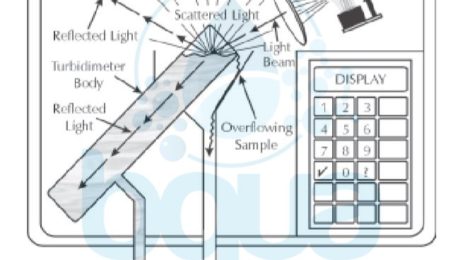What is Turbidity Definition
Turbidity is a parameter which measures the content of particulate foulants in the reverse osmosis feed water source. Turbidity can also be defined as the measurement of the light scattering properties of particles in suspension. The instrument used to measure turbidity is called a turbidimeter or turbidity meter.
The principle of turbidity meters is that suspended particles will block or reflect light. There are several different types of turbidity meters, but they are all based on the principle of particles blocking or reflecting light. Let’s look at reflected light first.
If there are no particles suspended in a sample, light will pass through the sample in a straight line. If a photocell (photoreceptor) is located at 90 degrees to the light path, no light will reach the photocell and the turbidity will read zero.
If particles present in a sample, the light will be reflected off of the surfaces of the particles and will be scattered at different angles. A photoreceptor at 90 degrees from the source of light will pick up light that is scattered and a turbidity measurement greater than 0 will be obtained.
The unit of measurement for turbidity is the NTU or the JTU or the FTU. There is no correlation between NTU and JTU and FTU. The term nephelometric indicates that this is a light-interference analytical technique. NTU is the measurement unit for light scattering. Some on-stream turbidity meters also use the light-scattering principle. A common one is called the surface scatter turbidimeter.
For a surface-scatter turbidimeter, the sample with suspended particles is passed up through a tube. A light source is shining on the surface of the liquid as it flows over the top of the tube. A photocell is located above the surface of the water. If there are no particulates in the water, the light beam is absorbed by the black tube and the black interior of the enclosure. If they are present, they scatter light as they surface (This is why this technique is called surface-scatter). The photocell picks up the scattered light and displays the reading in NTU.
There is another type of turbidimeter which doesn’t measure the light scattered but rather the reduction in transmitted light. In this case the full beam is received by the photocell. Full-beam reception equates to clean water and no turbidity.
 Â
If particles are present, less light reaches the photocell. This, then, is displayed as a turbidity reading, in JTU (Jackson Turbidity Unit, named after the man who created the standard candle which was originally used as the source of the light). Figure below illustrates particulates in the sample scattering, and therefore blocking, the light beams.
The turbidity level in the source of water is indicative of the content of clay, silt, suspended organic matter, and microscopic aquatic life. Such as phyto- and zooplankton. It is expressed in Nephelometric Turbidity Units (NTU) and Formazin Nephelometric Unit (FNU). The turbidity of open ocean and surface brackish water can vary between 0.1 and several hundred NTU, although under normal dry weather conditions, it is typically between 0.5 and 2.0 NTU. Rain events, algal blooms, storms, snow melt, river discharges, and human activity (such as wastewater discharges, ship traffic, etc.) can cause significant turbidity increases and variations. Usually, water that is saline with a turbidity below 0.05 NTU causes very low particulate fouling of the reverse osmosis membrane. Most RO membrane manufacturers have a maximum feed raw water turbidity of 1.0 NTU, although this level is relatively high in practical terms. Usually, filtered water turbidity below 0.1 NTU is desirable.
Although turbidity is a good measure of the overall content of particulates in the source water, on its own it is not an adequate parameter to characterize water’s potential for particulate or other fouling. Turbidity measurement does not provide information regarding the type and particle size in the source feed water and does not measure the constitution of dissolved organic and inorganic foulants. The size of particles contained in the source water matters because RO membrane feed and concentrate spacers, through which the saline raw water is distributed inside the membranes, are of limited width (typically 0.7 to 0.9 mm).
Even with these problems, turbidity measurements can be valuable trending indications for monitoring RO unit feed water. Most manufacturers require that the feed water to an RO unit be less than 1.0 NTU. Turbidity is almost always measured on feed waters which are processed through a clarifier. Clarifiers are usually found at facilities with a surface water source and no prior municipal treatment. In this case turbidity is frequently measured before and after the clarifier to monitor the performance of the clarifier. In a few cases, turbidity is measured before and/or after a multimedia filter to monitor performance of this piece of equipment. Turbidity or TSS measurements alone are insufficient to tell us about the fouling potential of our feed water. They must be used in conjunction with SDI (Silt Density Index).
- Published in Water Chemistry, Water Treatment
Water Treatment Oil and Gas
Purpose of Reverse Osmosis Systems is to support and help treatment of oil contaminated water to recover petroleum oils that are found in water bodies at several stations.
- Free non-emulsified oils
- Emulsified oils and stable in the water
- Insoluble solids
The principles of the separation, recovery and water treatment oil and gas depends on characteristics and properties of these oils; the nature and existence, solid materials and non-emulsified oils are physically separated while emulsified oils are chemically separated. Finally, small emulsions and organic dissolved material which were not treated with previous means are being treated biologically.
Stages and methods for water treatment oil and gas
Contaminated water are being processed by three phases depending on the method of processing which are:
- Physical treatment
- Chemical processing treatment
- Biological treatment stage
Physical treatment
Solid matters and non-emulsified oils are separated based on the principle of gravity, where design breaks is returned to the American Petroleum Institute, which the design depends on the principle of the difference in density between the water and oils properties, whether free or solid. Free oils float on the surface of the water and taken by a certain abrasive raze to a special hole to be returned again after layering to the production lines while the solid matters settle at the bottom of these basins are taken through a private in the form of sludge sockets to private places where follow up treatment and disposal.
Chemical processing treatment
Emulsified oils can not be separated physically so it needs to be separated chemically which allows to remove the case of emulsification and stability emerging between oil and water in the middle surrounding the second phase.
Where external water are brought from external basins after adding some coagulated materials such as iron sulfate which is less expensive than other coagulated materials and because they in fact do two jobs.
Forms (after oxidation by dissolved oxygen moiety) hydroxide compound of iron gelatin textures and surface, which has a capacity that helps adsorption of emulsified oil droplets on the surface and the air with the help of the dissolved.
The addition of iron sulfate helps in getting rid of hydrogen sulfide gas dissolved and compounds which may be contained with oily water, which have seriously damaged the subsequent biological treatment work, where the presence of iron sulfide is a moiety with ion iron deposit is a black iron sulfide.
After the formation of the raw material adsorption (ferric hydroxide) a polymer is added with high molecular weights that carries an electric positive charge on the surface collects iron hydroxide particles on the surface compounds the problem so volumes and surfaces wide capable of dissolved air flotation, which will inject later assisted.
Complete chemical treatment of so-called phase flotation stage, a very important and very critical stage in the improvement of the final specifications for water treatment and symbolized by the acronym of the dissolved air flotation.
The principle of this method depends on the density change problem solids by adding the previous chemicals by joining the air bubbles injected by a private network at the bottom of the tub to the surfaces of these pendants and its contribution to the expansion of the relative surfaces and thus reduce the intensity of which will allow its flotation.
In other words, what is meant by flotation in fact is the updraft of adsorption materials that will contribute to the adsorption of emulsified oil droplets at the same time also pick up solid natural pendants which we call water turbidity collected on the surface of the flotation tanks.
Then to be taken by a special raze gathered in private protectors called flotation sludge pit.
Biological treatment stage
Emerging from the flotation stage water enters the biological treatment providers basins mechanical mixers are secure ventilation of these basins and providing oxygen required for processes of oxidation where this method is the most common and successful way in converting organic material, whether decadent or sizes minutes impossible separated previous stages to non-material decadent through oxidized by microorganisms (bacteria) that are converted via vital metabolism to carbon dioxide and to new microorganisms called bacterial midwife to be placed at the bottom attached to the biological reactors settling basins and described in the third stage in the scheme.
Many of the microorganisms can feed on organic material dissolved or suspended and disassembled condition of maintaining the appropriate conditions of her life and, in particular, needs oxygen.
And measured the water content of organic material degradable bacteria, including the requirement we call organic oxygen: BOD Biochemical Oxygen Demand.
This standard represents the amount of oxygen consumed by bacteria to represent this organic material and can be called organic pregnancy basin biological When this pregnancy is fairly low and if there is sufficient tracts of land are designed in this case the biological basins Allagoonat system or open pits where believes bacteria which need oxygen directly from the natural air.
But if the high organic load must in this case from those basins oxygen supply mechanical means which are periodically required to secure for the entire basin ventilation.
- Published in Water Treatment



